Advertisement
How pavement can help cool overheated cities, even in chilly Mass.
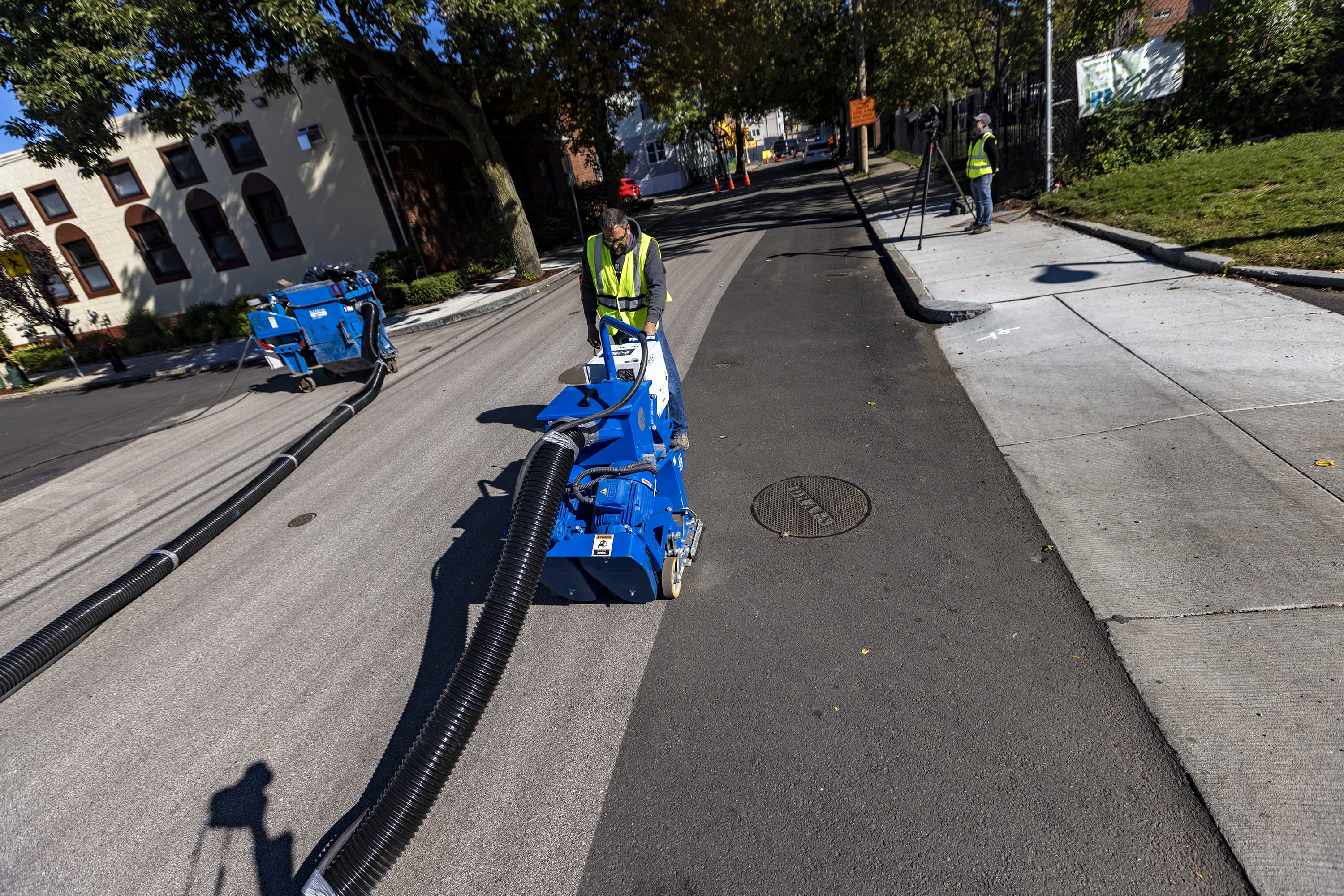
On a typical summer day, it might be 10-12 degrees cooler in leafy sections of Boston than it is downtown, because unshaded pavement and roofs absorb and radiate so much heat.
Reducing pavement or making it more reflective are strategies more communities must adopt to help cool cities, experts say, and slow global warming. One of the dire challenges with pavement is how much heat it radiates at night.
“It’s this inability to cool down at night that leads to some of the worst health effects,” says Carly Ziter, an associate professor of biology at Concordia University in Montreal.
Heat radiating off asphalt, concrete and bricks overnight can disrupt sleep. Lack of sleep can aggravate chronic conditions such as heart disease, diabetes and anxiety. Some researchers forecast more deaths connected to excessive nighttime heat.
More than a dozen U.S. cities, mostly in central or southern states are testing ways to cool pavement, in addition to planting trees and coating roofs white. In Massachusetts, where being too cold has historically been more of a concern than being too hot, there are a few experiments, but most decision makers are waiting and watching. There’s not much research about what works, on which surfaces, and in what settings.
Shot blasting asphalt in Chelsea
In late September, a machine that looked like an oversized floor sander rolled slowly up and down the street in front of Chelsea’s Boys and Girls Club. Tiny metal beads pummeled the top black layer of asphalt, leaving it light gray.
“It’s striking,” says Tim Corrigan, an engineer with Weston and Sampson, “and what we hoped to see here.”
Asphalt fades from black to gray over time. This technique, called shot blasting, speeds up that process. Pavement color makes a big difference when it comes to heat. Black asphalt absorbs more sun than concrete, for example, and can be about 20 degrees hotter. Bringing asphalt closer to the color of concrete is the aim of many cool pavement projects.
“Our goal is to make the pavement hold less of the heat from the sun and reflect it back into the atmosphere,” says Corrigan, who proposed this experiment for Chelsea, an urban heat island where summer temperatures are often 10 or more degrees warmer than in suburbs.
Advertisement
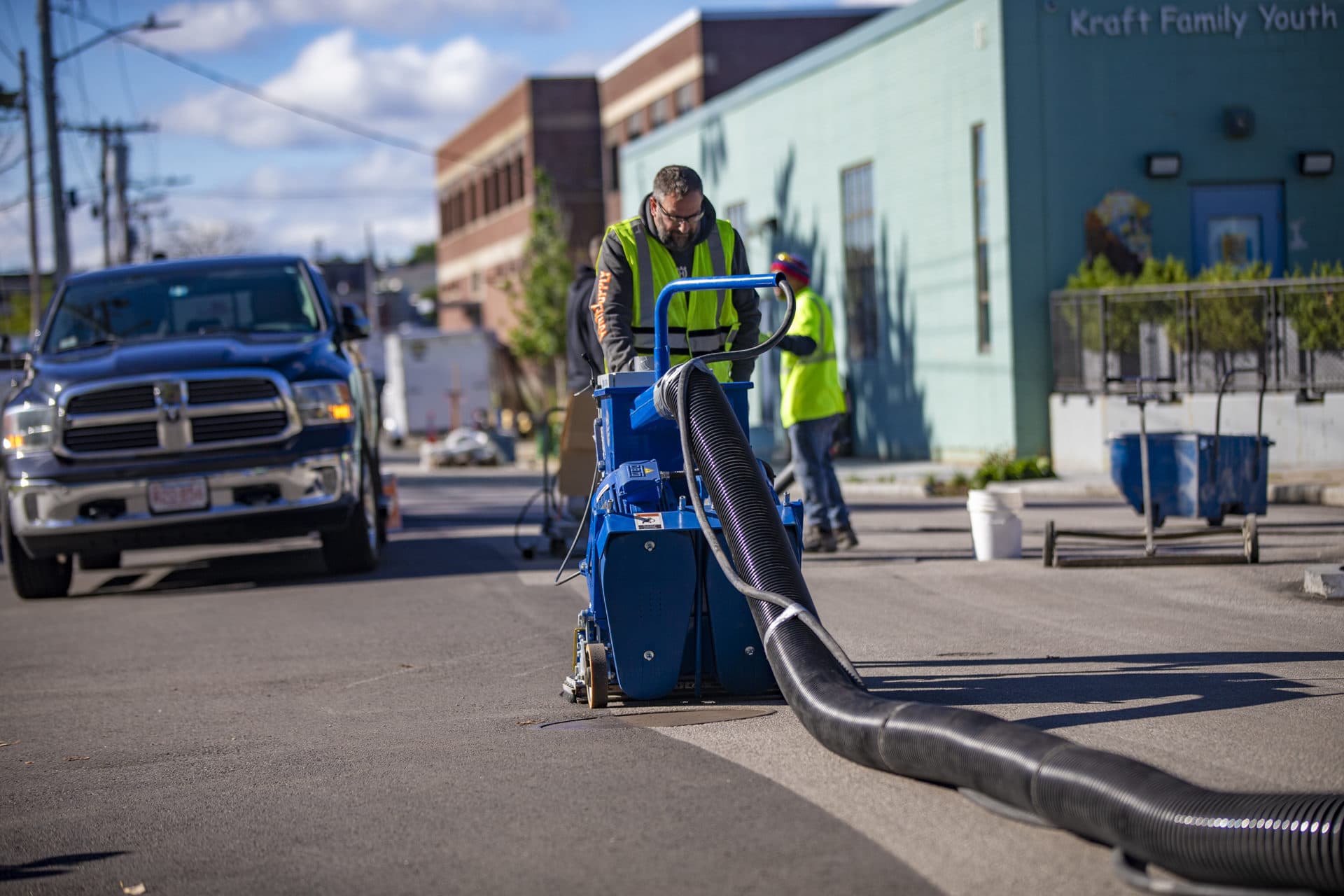
More than 85% of Chelsea is covered by roads, parking lots or buildings. So finding ways to cool city-owned surfaces is a vital piece of Chelsea’s heat mitigation plan. Roughly 20% of Chelsea residents live below the poverty line, and many others can’t afford air conditioning.
The National Asphalt Pavement Association says shot blasting to cool pavement is being used in Europe but not in the U.S., as far as staff know. For this experiment, Chelsea worked with the asphalt manufacturer Aggregate Industries to produce a special mix with lighter stones.
Chelsea city officials are also working with Boston University researchers to monitor the temperature near this street and compare the effects. The street lines one side of a block where the city is testing a number of urban cooling techniques.
Chelsea could have asked Aggregate to add tan, gray or another light color to the asphalt, but that would have been four times more expensive.
As it is, the special mix with lighter colored stones — and shot blasting this section of road — cost about $55,000. Multiplying that across city streets would add up quickly.
The big player when it comes to roadways in Massachusetts is the state. Some city planners say the Massachusetts Department of Transportation, MassDOT, isn’t changing its pavement practices quickly enough.
But MassDOT spokeswoman Jacquelyn Goddard says the department is working to make pavement more environmentally friendly. That includes recycling old roadway material, purchasing asphalt produced in a less carbon-intensive way and incorporating more porous pavement. The agency is also assessing other products, including asphalt that absorbs and stores carbon dioxide.
“Pavement technology is one of the largest project areas of our research programs,” Goddard said in a statement.
MassDOT does not plan to try one particular cooling strategy: reflective paint. The agency says paint would produce too much glare for high-speed roadways and isn’t durable enough. It might make more sense on low-speed sites like parking lots.
Cambridge mulls more painted parking lots
Kevin Beuttell doesn’t like the scuff marks. No one expects a parking lot to be pristine, but the black marks seem to stand out on this once uniformly gray surface.
Beuttell points across a lot Cambridge painted in June 2021. It was the city’s first test of this approach that Phoenix and Los Angeles are using to try to reduce heat. Beuttell, the city’s supervising landscape architect, says Cambridge will likely paint more city-owned lots even though the results are “not quite as good as the marketing material would have you believe.”
A study Cambridge commissioned found the painted lot reflected about the same amount of sun as did concrete sidewalks. Dirt and those scuff marks likely reduced the paint’s reflectivity. The upshot: the lot is retaining and emitting more heat than expected but still less than asphalt.
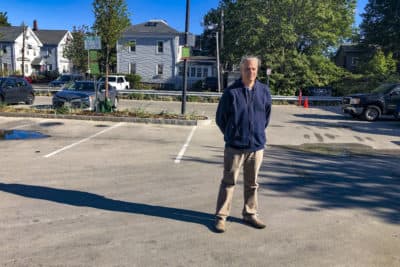
Some municipal leaders say they are cautious about using paint to cool pavement, because the sunshine that bounces off a beige or gray lot may hit buildings. That could lower heating bills in the winter but increase cooling costs in the summer.
And, the light that bounces off lighter, reflective pavement may get absorbed by pedestrians. It is more like walking on concrete than asphalt. Cambridge hasn’t had any complaints, but Beuttell gets the concern.
“It can actually be quite a bit less comfortable on a lighter surface than a darker surface, because you're getting hit not only by the sun, but also by that heat reflecting off the pavement,” Beuttell says.
Still, Beuttell says paint may be a fine option for parking lots where people don’t typically hang out. Researchers who’ve studied the effects of painted streets in Los Angeles reached a similar conclusion: make parking lots or streets that don’t get much foot traffic lighter and more reflective — or plant trees to shade these surfaces.
“If you want to cool people, plant trees. If you’re trying to reduce the urban heat island effect, especially at night, then cool pavement might be a good strategy,” says Ariane Middel, lead author on the L.A. street painting study. “If you smartly combine strategies you’ll get the most benefit.”
The Cambridge lot includes a small strip of trees. And there are lots of new trees on Chelsea’s cool block with the shot blasted asphalt. Trees have many benefits, but when it comes to cooling pavement, there are limits.
Ziter’s research shows trees can only significantly counteract the heat pavement radiates if at least 40% of a paved area is shaded. That’s more tree cover than many city streets and parking lots have room for. And trees aren’t effective at night.
More trees and cooler pavement are some of the more manageable steps municipal leaders can take to reduce temperatures at night and prevent more heat-related health harm.
“[Pavement] is under the control of city authorities,” says Hessam AzariJafari, deputy director of MIT’s Concrete Sustainability Hub. They “can use it to achieve their carbon neutrality goals, but it hasn’t been well discussed yet.”
Research out of MIT shows that a moderate increase in reflectivity would lower air temperatures in on average in U.S. cities by 2.5 degrees. The cumulative effect would be 41% fewer days over 105 degrees.
And lighter colored, more reflective pavement could help offset the carbon dioxide cars send into the atmosphere, says Randy Kirchain, who co-directs the Concrete Sustainability Hub. Kirchain would like to see a lot of reflective streets and parking lots bouncing light back, and possibly through, the blanket of CO2 that is warming the planet.
“If we reflect more energy back out, it’s the same as emitting less CO2,” Kirchain says “and making the blanket thinner.”
Another approach: get rid of or install less pavement.
Smaller parking lots means less pavement
Vast parking lots at malls and shopping centers contribute to extreme heat in many Massachusetts communities, including Natick, Burlington, Norwood, Framingham and Fitchburg, where Nick Erickson is the public works commissioner. He and other municipal leaders are starting to ask — do we need all this parking?
On a recent fall day, Erickson stands in front of a strip mall with many empty storefronts, looking across a nearly vacant lot.
“The parking lot that you see here is just a sea of asphalt, made to hold lots of cars because that's what it was designed to do back in the day,” Erickson says.
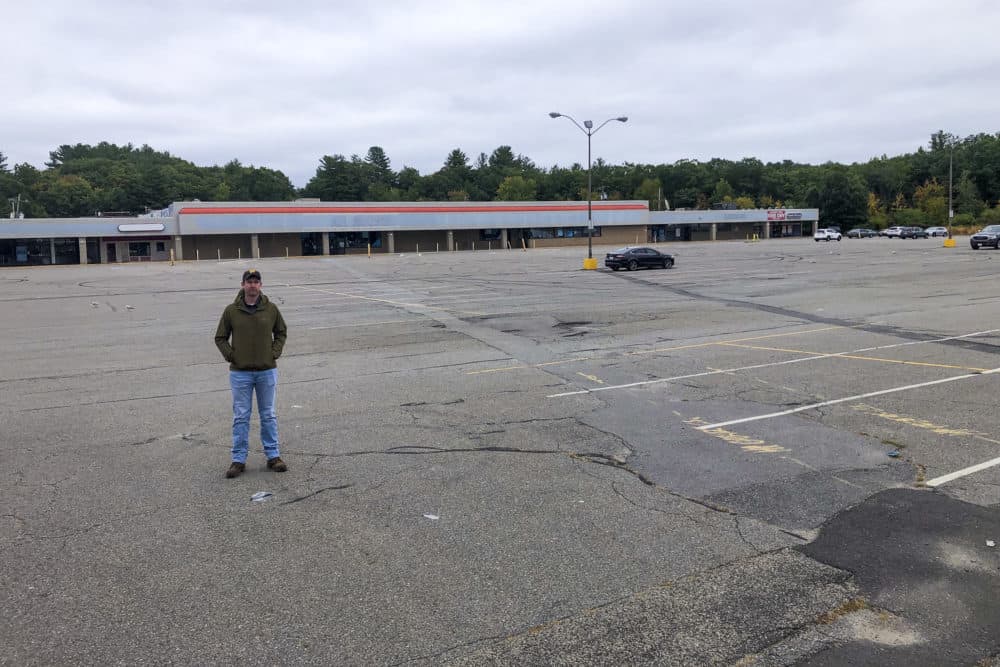
Erickson envisions ripping out a strip of pavement through the middle of the lot and restoring a stream that used to run through it.
“We’d basically create a new stream channel through the parking lot,” he says, “with green space on either side of the channel, a bridge or two to allow vehicular access or pedestrian access to the stores.”
Erickson’s goal is to stop flooding. The stream diverted to build this strip mall often jumps its banks during heavy rain and pours into the lot. Flooding and stormwater runoff, not heat, are the main reasons municipal leaders like Erickson talk about removing pavement or replacing it with permeable pavement, trees, bushes or grass.
The idea that communities also need these changes to cope with rising temperatures is just starting to take hold. State grants through the Municipal Vulnerability Preparedness program are helping fund new pavement strategies and other projects related to climate change. The state has awarded $100 million to 341 communities since 2017.
Mendon reduced pavement around municipal buildings by 36%, making room for a pocket park and rain garden. Shrewsbury is using grant money to analyze existing parking needs and look for ways to reduce pavement.
Other communities are spending the funds to replace pavement with greenspace. Fitchburg plans to get rid of the middle lane on a major thoroughfare and plant trees along the road. Millbury built green buffers at street corners with landscaping, not more pavement.
Several communities received money to map how much pavement they have and assess alternatives.
The mindset in Boston and neighboring cities has been “never enough” when it comes to parking. Some residents are joining communities ready to buck that tradition.
A hands-on approach to pavement removal
“One of the selling points was that you could park six cars here,” says Amanda Rychel, a homeowner in one of the state’s hottest cities, Somerville. “It wasn’t a selling point for us. We have one car and six bikes.”
Rychel didn’t need the parking, but buying a home with pavement she could remove was enticing.
"There’s just too much pavement in Somerville," Rychel says. “It’s bad for our rivers because rain just runs off pavement into the sewers. And it makes the city hotter."
So Rychel and her husband, Darren Begley, are hosting an asphalt smashing party. About 15 volunteers with the local group, DePave the Way, wield sledge hammers, crowbars and shovels to break up asphalt that covers much of the Rychel Begley yard. Rychel says she thinks the former owners of her home paved for easier maintenance. Paved yards are a trend reported in cities with lots of rental property.
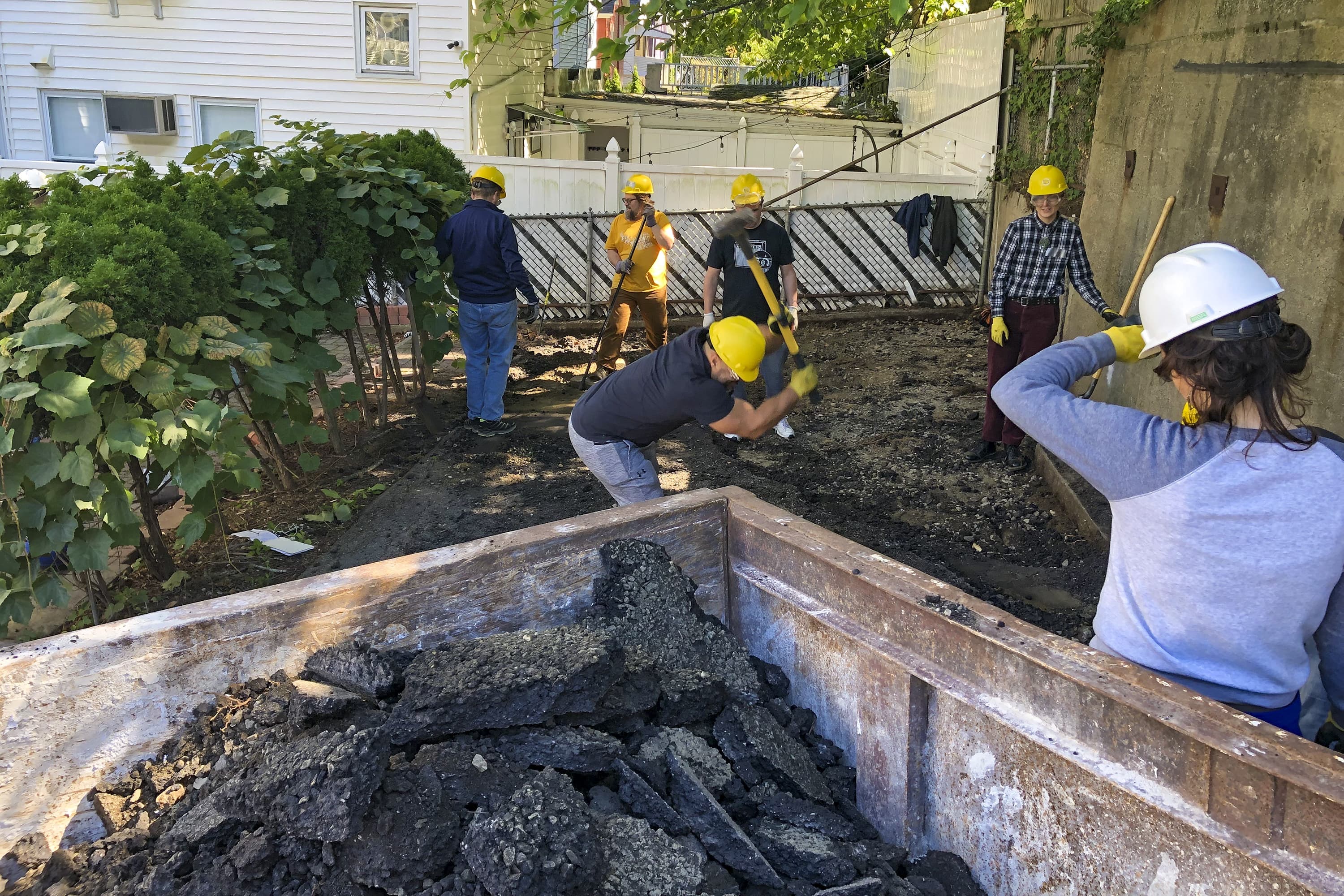
“Are we halfway done yet?” asks Begley as he inches up to a straight back. Begley can almost see the grass and garden he and Rychel hope to plant soon.
“I have a dog,” Begley explains. “We want him to have a place to run around and use the bathroom — so I don’t have to put my shoes on. Basically, this is all for the dog.”
In dense cities, any significant effort to replace gray surfaces with more green may not be possible without major redesigns.
Rethinking pavement in city design
Jordan Zimmermann has a suggestion: build up, not out.
Zimmermann, an architect, described the idea in a 2019 report for the Urban Land Institute. Zimmermann’s section proposed redeveloping the main shopping area in East Boston, where she lives. Parking lots in front of a grocery store and pharmacy take up a lot of space in this compact neighborhood and add to problems with heat.
“Our main concept was to trade density for open space,” says Zimmermann. “Rather than having a large swath of asphalt, you’d have a lot of greenspace.”
Parking, stores and some residential units would be stacked in a new tower. A white roof on top of the tower could dramatically reduce the heat this parcel and many other strip malls emit on hot days. The changes would be expensive. Zimmermann says the project might be attractive if the city granted developers zoning rights for the taller building with more space.
There are already some incentives for developers to use more reflective pavement, install solar panels over parking lots, or not including parking at all.
But for parking, developers may not have a choice.
“When it comes to the quantity of pavement which is causing the heat island effects,” says Conor McGuire, “if zoning was not requiring a lot of this paving, the developers would be happy to build less parking.”
McGuire chairs the sustainability committee for the Associated General Contractors of Massachusetts.
Residents often complain about parking limits and fight plans for taller structures. Zimmermann says neighborhoods may need to become more flexible to cope with the effects of climate change.
“We need to rethink the status quo,” says Zimmermann, “and be open minded about how we might see development change to reduce heat island effects and provide a more sustainable infrastructure.”
This segment aired on October 24, 2022.
